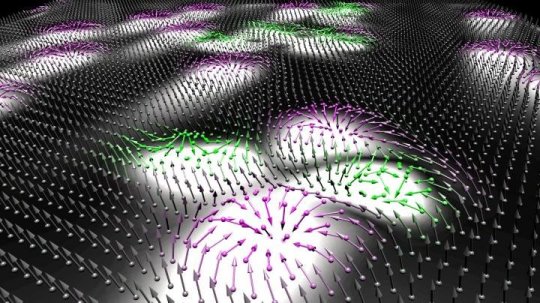[ad_1]
Nanosized magnetic particles called skyrmions are considered highly promising candidates for new data storage and information technologies. Now, physicists have revealed new behavior involving the antiparticle equivalent of skyrmions in a ferromagnetic material. The researchers demonstrated their findings using advanced computer simulations that can accurately model magnetic properties of nanometer-thick materials. The results, which were obtained by scientists at Uppsala University in Sweden, at Kiel University and Johannes Gutenberg University Mainz in Germany, and at Université Paris-Saclay in France, were recently published in Nature Electronics.
Moving electrons around in circuits is the basis for creating useful functions in electronics. But would their guiding principles still apply for positrons, i.e., the antiparticle version of electrons? Besides their scarcity in nature, basic electrodynamics suggests that everything would essentially function the same way with positive charges as it does with the negative ones of electrons — up to a difference in sign, since electrons and positrons move in opposite directions in electromagnetic fields.
However, this question remains open for nanoscale magnetic particles called skyrmions. Skyrmions represent whirls of magnetic moments that extend across a few nanometers and can be found in magnetic films a few atoms thick. In the same way that spheres and doughnuts have different topologies, skyrmions possess a special property called topological charge which plays a similar role to electric charges when their dynamics are concerned. For example, if an applied force causes skyrmions to be deflected toward the left, then that same force will lead antiskyrmions, their antiparticle counterpart, to deflect toward the right. Since the first experimental observations in 2009, skyrmions have been the focus of intense research because they offer new ways to store data and process information.
Simulation shows periodical evolution of skyrmion-antiskyrmions pairs
Now physicists have shown that much richer phenomena can occur in nanometer-thick ferromagnets in which both skyrmions and antiskyrmions coexist. By using state-of-the-art simulation techniques to compute the magnetic properties and dynamics in such films, they studied how skyrmions and antiskyrmions respond when electric currents are applied to exert a force on them. At low currents, the expected behavior is seen where opposite topological charges get deflected in opposite directions as a result of the same applied forces. As the current is gradually increased, however, their motion no longer mirrors each other. While skyrmions continue to travel in straight lines, antiskyrmions begin to undergo curved trajectories, initially as transients and then continuously as the currents are further increased. In the latter the trajectories resemble trochoids, similar to the curve traced out by the pedal of a bicycle that is pedaled along a straight path. These striking results illustrate that opposite topological charges can in fact behave very differently.
But more surprises were still in store. By increasing the amount of energy transferred to the system from the applied currents, the researchers found that the trochoidal motion can evolve to skyrmion-antiskyrmions pairs being created periodically. Because they move differently, the skyrmions created readily propagate away while the trochoidal motion of antiskyrmions means that they remain more localized to where they are created. Remarkably, each antiskyrmion created subsequently becomes a new source of pairs, resulting in a proliferation of such particles. “To put this into perspective: this is akin to sending a single positron through a strong magnetic field and getting a gas of electrons and positrons in return,” explained Dr. Bertrand Dupé, researcher in the Interdisciplinary Spintronics Research Group at Johannes Gutenberg University Mainz (JGU) and senior author of the study.
Results may provide hints to the matter/antimatter enigma
The consequences of this theoretical work are potentially far-reaching. For future technologies, the study suggests that antiskyrmions could be a ready source of skyrmions, which would be crucial for any application that uses skyrmions to transmit and store information. Moreover, the onset of trochoidal motion sets the ultimate speed limit of such topological charges, which is an important parameter in designing any future circuits using skyrmions.
More fundamentally, the work may provide hints for solving a bigger mystery on cosmological scales, namely, why there is more matter than antimatter in the observable universe. Because of the asymmetry in the motion of skyrmion and antiskyrmions, the simulations show that there is always an excess of skyrmions after pair creation, so the imbalance between “matter” and “antimatter” in these ferromagnetic films is a natural consequence of their dynamics at high energies. “In the nanoscale magnetic universe, at least, matter can arise naturally from a single antiparticle seed,” Dupé said.
Story Source:
Materials provided by Johannes Gutenberg Universitaet Mainz. Note: Content may be edited for style and length.
[ad_2]















